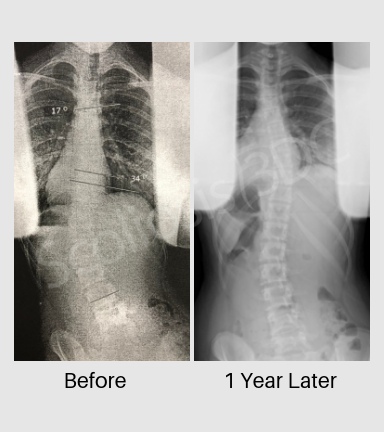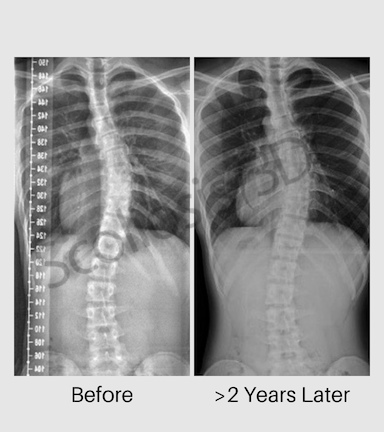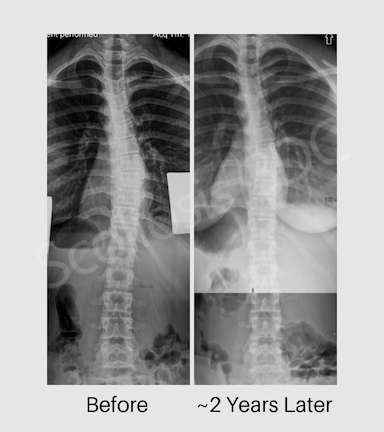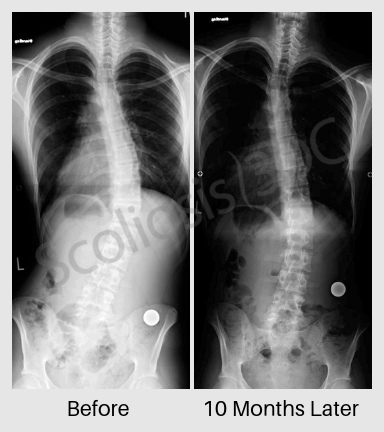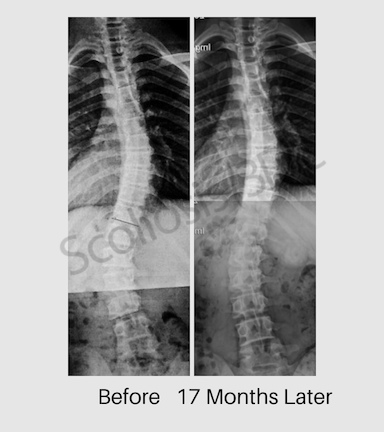Jump To Results List
Moderate scoliosis is a spinal curvature measuring 25°-44° according to Cobb angle (measured on an AP/PA scoliosis xray). Patients with moderate scoliosis typically fall into one of two groups. They may have just been diagnosed with a moderate curve (either due to a previously undetected curve or due to a sudden onset of a moderate scoliosis). Or, they may have been previously diagnosed with a mild scoliosis that has progressed under a ‘wait and see’ approach. The majority of our patients fall into the moderate scoliosis category as it’s when most doctors will recommend starting treatment, usually with a back brace. With that said, moderate scoliosis treatment recommendations can vary widely depending on which end of the spectrum a patient falls. As with other scoliosis severity levels, stage of growth also plays a major role.
Different Recommendations for Moderate Scoliosis Treatment
Different practitioners will have differing opinions about treatment based on their experience, philosophy, and openmindedness about conservative scoliosis treatments. The most straightforward example is a patient with a 25°-35° scoliosis with significant growth remaining (Risser 0, 1, or 2). Most doctors will recommend full-time scoliosis bracing for these patients (18-23 hours a day). This is to prevent scoliosis from getting worse during growth and to try to help the patient avoid scoliosis surgery. The type of scoliosis brace recommended will vary by doctor. Scoliosis exercises may or may not be recommended as an adjunct treatment. Generally speaking, in our practice, we find that patients who incorporate bracing and scoliosis specific exercise (i.e. Schroth method) do better than bracing alone.
Unlike the Cheneau-Gensingen , the most common scoliosis braces are not designed to be highly corrective in larger scoliosis curves ≥40°. For this reason, bracing for 40°+ has been dubbed ineffective. Orthopedic surgeons will typically recommend or forewarn of impending future surgery in this subset of patients. Similarly, when scoliosis is diagnosed at the later stages of maturity (Risser 4 or 5) and/or with a higher Cobb angle (again for example, around 40°), an orthopedic surgeon may say there’s nothing that can be done. It is at this point that a second type of ‘wait and see’ may occur – essentially not taking any action and waiting to see if surgery will be ‘required.’
Moderate Scoliosis Treatment at Scoliosis 3DC
At Scoliosis 3DC, we tend to disagree with moderate scoliosis treatment recommendations typically provided by orthopedic surgeons. We are also philosophically opposed to wait and see, at any point. First, there are newer asymmetric-style braces such as the Cheneau-Gensingen which are designed to address larger scoliosis angles not typically referred for bracing. Second, we advocate for scoliosis-specific exercises to stabilize and strengthen the spine for patients who are still growing (to attempt to improve the curvature) and for more skeletally mature patients. This is to help patients avoid progression and stave off the threat of surgery later on, or in adulthood. Please check out our moderate scoliosis treatment results, which are divided into subcategories of 25°-34° and 35°-44°. If you are seeking more information about treatment for moderate scoliosis, please contact us at 781-938-8558 or at info@scoliosis3dc.com.

